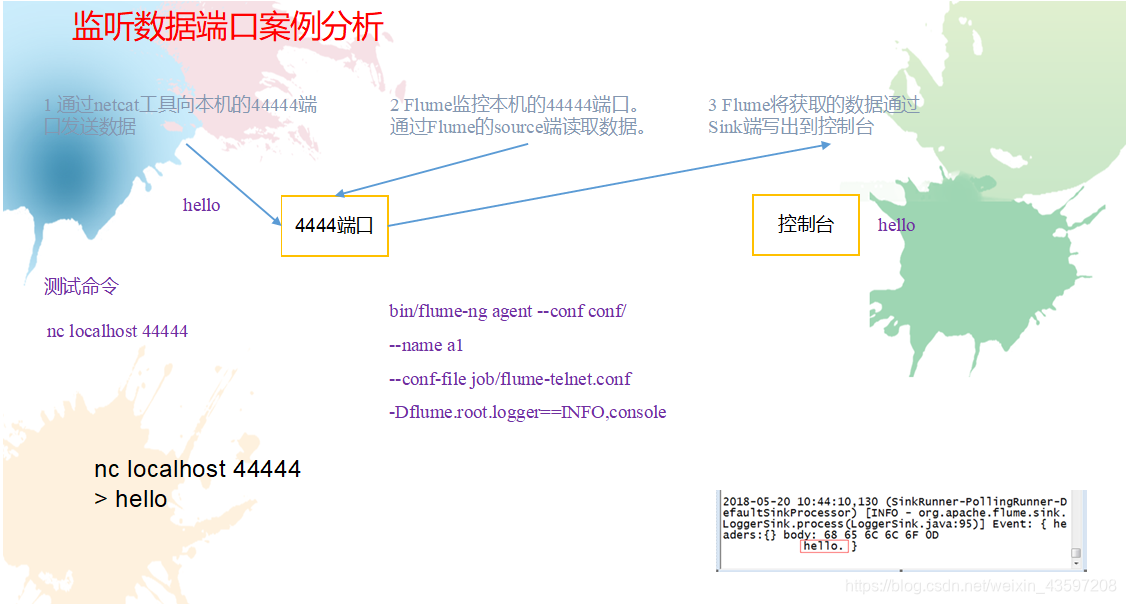大数据之Flume:Flume监控端口数据官方案例
本文共 1553 字,大约阅读时间需要 5 分钟。
1 监控端口数据官方案例
1)案例需求: 使用Flume监听一个端口,收集该端口数据,并打印到控制台。 2)需求分析: 3)实现步骤: 1.使用的组件 (1)netcat source :作用是监听某个tcp端口收到的数据,将每行封装成一个event (2)Logger sink :使用logger(日志输出器)将event输出到文件或者控制台 (3)Memory Channel 1.安装netcat工具 [hadoop@hadoop101 software]$ sudo yum install -y nc 2.判断44444端口是否被占用 [hadoop@hadoop101 flume-telnet]$ sudo netstat -tunlp | grep 44444 3.创建Flume Agent配置文件flume-netcat-logger.conf 在flume目录下创建job文件夹并进入job文件夹。 [hadoop@hadoop101 flume]$ mkdir job [hadoop@hadoop101 flume]$ cd job/ 在job文件夹下创建Flume Agent配置文件flume-netcat-logger.conf。 [hadoop@hadoop101 job]$ vim flume-netcat-logger.conf 在flume-netcat-logger.conf文件中添加如下内容。
3)实现步骤: 1.使用的组件 (1)netcat source :作用是监听某个tcp端口收到的数据,将每行封装成一个event (2)Logger sink :使用logger(日志输出器)将event输出到文件或者控制台 (3)Memory Channel 1.安装netcat工具 [hadoop@hadoop101 software]$ sudo yum install -y nc 2.判断44444端口是否被占用 [hadoop@hadoop101 flume-telnet]$ sudo netstat -tunlp | grep 44444 3.创建Flume Agent配置文件flume-netcat-logger.conf 在flume目录下创建job文件夹并进入job文件夹。 [hadoop@hadoop101 flume]$ mkdir job [hadoop@hadoop101 flume]$ cd job/ 在job文件夹下创建Flume Agent配置文件flume-netcat-logger.conf。 [hadoop@hadoop101 job]$ vim flume-netcat-logger.conf 在flume-netcat-logger.conf文件中添加如下内容。 # Name the components on this agenta1.sources = r1a1.sinks = k1a1.channels = c1# Describe/configure the sourcea1.sources.r1.type = netcata1.sources.r1.bind = localhosta1.sources.r1.port = 44444# Describe the sinka1.sinks.k1.type = logger# Use a channel which buffers events in memorya1.channels.c1.type = memorya1.channels.c1.capacity = 1000a1.channels.c1.transactionCapacity = 100# Bind the source and sink to the channela1.sources.r1.channels = c1a1.sinks.k1.channel = c1
4.先开启flume监听端口
[hadoop@hadoop101 flume]$ bin/flume-ng agent -c conf/ -n a1 -f job/flume-netcat-logger.conf -Dflume.root.logger=INFO,console
参数说明:
-c:表示配置文件存储在conf/目录 -n:表示给agent起名为a1 -f:flume本次启动读取的配置文件是在job文件夹下的flume-telnet.conf文件。 -Dflume.root.logger=INFO,console :-D表示flume运行时动态修改flume.root.logger参数属性值,并将控制台日志打印级别设置为INFO级别。日志级别包括:log、info、warn、error。 5.使用netcat工具向本机的44444端口发送内容[hadoop@hadoop101 ~]$ nc localhost 44444hello bigdata
6.在Flume监听页面观察接收数据情况

转载地址:http://xmoh.baihongyu.com/
你可能感兴趣的文章
nginx看这一篇文章就够了
查看>>
Nginx简单介绍
查看>>
Nginx访问控制_登陆权限的控制(http_auth_basic_module)
查看>>
nginx负载均衡和反相代理的配置
查看>>
nginx负载均衡器处理session共享的几种方法(转)
查看>>
nginx负载均衡的5种策略(转载)
查看>>
nginx负载均衡的五种算法
查看>>
nginx转发端口时与导致websocket不生效
查看>>
Nginx运维与实战(二)-Https配置
查看>>
Nginx配置Https证书
查看>>
Nginx配置ssl实现https
查看>>
Nginx配置TCP代理指南
查看>>
Nginx配置——不记录指定文件类型日志
查看>>
nginx配置一、二级域名、多域名对应(api接口、前端网站、后台管理网站)
查看>>
Nginx配置代理解决本地html进行ajax请求接口跨域问题
查看>>
nginx配置全解
查看>>
Nginx配置参数中文说明
查看>>
Nginx配置后台网关映射路径
查看>>
nginx配置域名和ip同时访问、开放多端口
查看>>
Nginx配置多个不同端口服务共用80端口
查看>>